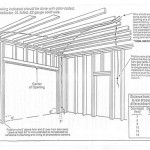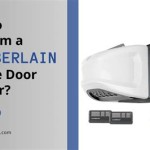How To Align Electric Eye On Garage Door Opener
The electric eye, also known as the safety sensor, is a critical component of a garage door opener system. Its primary function is to prevent the garage door from closing if an obstruction is detected in its path. This safety feature relies on two sensors – one emitting an infrared beam and the other receiving it. Proper alignment of these sensors is crucial for the garage door opener to operate safely and reliably. When misaligned, the door may refuse to close, or worse, may close unexpectedly on an obstruction. This article provides a comprehensive guide on how to align electric eyes on a garage door opener.
Understanding the importance of proper alignment is the first step. The system works by sending an invisible infrared beam across the opening of the garage door, a few inches above the ground. If this beam is uninterrupted, the garage door opener considers the path clear and will allow the door to close. If anything, be it a person, pet, or object, breaks the beam while the door is closing, the opener should immediately reverse direction and open the door. When the sensors are misaligned, the receiver may not detect the beam, leading to a false indication of an obstruction. This can be frustrating for homeowners, as the garage door will repeatedly open rather than close.
Before attempting any alignment procedures, it is essential to ensure that the issue genuinely stems from misalignment and not from other potential problems. Thoroughly inspecting the system for other common causes is always advised. These potential problems include something blocking the sensors, a damaged sensor, or wiring issues.
Key Point 1: Identifying Common Causes of Electric Eye Malfunctions
Before jumping to the conclusion that the electric eyes are misaligned, it is imperative to rule out other factors that could be causing the problem. This systematic approach can save time and effort by addressing the actual source of the issue.
Firstly,
obstructions
are a frequent culprit. Even small objects such as leaves, cobwebs, or dirt can interfere with the infrared beam. Carefully inspect the area around both sensors, ensuring that there is a clear, unobstructed path between them. Use a clean, dry cloth to wipe the lenses of the sensors, removing any accumulated debris. Be gentle to avoid scratching the sensor lenses.Secondly,
wiring problems
can disrupt the signal transmission between the sensors and the garage door opener unit. Check the wires connected to each sensor, ensuring they are securely attached and free from damage. Look for any signs of fraying, corrosion, or disconnection. If you notice any damaged wires, they should be repaired or replaced by a qualified electrician. Sometimes, the issue might be a loose connection at the terminal screws. Ensure that the wires are properly seated and the screws are adequately tightened.Thirdly,
sensor damage
can prevent the electric eyes from functioning correctly. While less common than obstructions or wiring problems, physical damage to the sensors themselves can occur due to accidental impacts or environmental factors. Visually inspect the sensors for any cracks, dents, or other visible damage. If a sensor is damaged, it will likely need to be replaced. The replacement sensor should be the exact same model or a compatible version recommended by the garage door opener manufacturer. Trying to mix and match sensors from different brands or models might cause compatibility issues preventing proper function.Finally,
power issues
can cause the sensors to intermittently fail. This can be tested using a multimeter at the power connection of the sensors. The voltage range that is required should be noted in the user manual.After carefully addressing these potential causes and ensuring that none of them are the source of the problem, you can proceed with the alignment procedures.
Key Point 2: Step-by-Step Guide to Aligning Electric Eyes
Following a structured, step-by-step approach ensures a systematic and effective alignment process.
Step 1: Initial Observation.
Begin by observing the indicator lights on each sensor. Typically, one sensor will have a solid light indicating that it is emitting the infrared beam. The other sensor will have a light (either solid or blinking) that indicates whether it is receiving the beam. If the receiving sensor's light is off or blinking rapidly, it suggests that the beam is not properly aligned. The specific behavior of the lights can vary depending on the manufacturer and model of the garage door opener, so consult the owner's manual for detailed information regarding the meaning of the indicator lights.Step 2: Loosening Mounting Brackets.
Use a screwdriver or wrench to gently loosen the screws or bolts that secure the sensors to their mounting brackets. Do not remove the screws entirely, as they only need to be loose enough to allow for slight adjustments to the position of the sensors. Be careful not to overtighten these screws when re-tightening them later, as this could damage the brackets or the sensors themselves.Step 3: Manual Adjustment.
Carefully pivot the sensors up and down, left and right, until the receiving sensor's light turns solid. This indicates that it is now properly receiving the infrared beam from the emitting sensor. This step may require some patience, as the adjustment needed might be very subtle. It can be helpful to have someone assist you by observing the indicator lights while you make the adjustments. When one sensor is moved, it might slightly affect the angle of the other sensor. Therefore, you might need to adjust both sensors to achieve perfect alignment.Step 4: Fine-Tuning.
Once the receiving sensor's light is solid, make small adjustments to the position of both sensors to maximize the strength of the signal. Some garage door openers have a signal strength indicator that can be used to guide this fine-tuning process. If such an indicator is available, adjust the sensors until the signal strength is at its maximum level. Even without a signal strength indicator, you can make fine adjustments by slightly moving the sensors and observing the behavior of the receiving sensor's light.Step 5: Securing the Brackets.
After achieving proper alignment and maximizing the signal strength, carefully tighten the screws or bolts on the mounting brackets to secure the sensors in their aligned positions. Ensure that the sensors are firmly in place, but avoid overtightening the screws. Overtightening can damage the brackets or sensors. After tightening the screws, double-check the alignment by observing the indicator lights on both sensors. If the lights change after tightening the screws, you may need to loosen the screws again and readjust the sensors.Step 6: Testing.
After securing the sensors, test the functionality of the garage door opener by attempting to close the door. As the door closes, pass an object (such as a broom handle or a piece of cardboard) through the path of the infrared beam. The garage door should immediately reverse direction and open. If the door fails to reverse when the beam is interrupted, recheck the alignment of the sensors and repeat the previous steps.Key Point 3: Troubleshooting Common Alignment Issues
Even after following the alignment steps, some issues may persist. Understanding common problems and their solutions helps ensure a successful outcome.
One common issue is
Intermittent Functionality
. The garage door might work correctly sometimes but fail at other times. This can be caused by a number of factors, including loose wiring, fluctuating power, or subtle misalignment that is easily disrupted by vibrations or temperature changes. Check and secure all wiring connections, ensure a stable power supply, and consider using shims to stabilize the sensor brackets.Sensitivity to Sunlight
can be another problem. Direct sunlight can interfere with the infrared beam, causing the sensors to malfunction, especially during certain times of the day. Consider installing shading over the sensors to block direct sunlight. Repositioning the sensors slightly to avoid direct sunlight can also help.Damaged Mounting Brackets
can make it difficult or impossible to align the sensors properly. If the brackets are bent, broken, or corroded, they should be replaced. Replacement brackets should be the exact match of the original brackets to ensure compatibility. When replacing brackets, ensure that the new brackets are securely mounted to the garage wall or door frame.Incorrect Sensor Placement
can also impede proper alignment. The sensors should be mounted at the correct height (typically 4-6 inches above the floor) and should be facing each other directly. If the sensors are mounted too high or too low, or if they are not aligned horizontally, the infrared beam may not be able to reach the receiving sensor. Measure the height of the sensors to ensure they are level, and use a level to ensure that the brackets are mounted straight.Communication Issues
between the sensors and the garage door opener unit can also mimic alignment problems. Ensure that the sensors are compatible with the garage door opener and that they are properly configured. Some garage door openers require specific sensor models or settings. Refer to the owner's manual for detailed information on sensor compatibility and configuration. Resetting the garage door opener to its factory settings and then reconfiguring the sensors can resolve communication issues.Addressing these common issues can significantly improve the reliability of the garage door opener system and ensure the safety of its operation. If after attempting to address these issues, the problem persists, consulting a qualified garage door technician is highly recommended.
Proper alignment of the electric eyes is a key aspect of maintaining a safe and functional garage door opener system. By understanding the importance of alignment, identifying potential causes of malfunctions, following a systematic alignment procedure, and troubleshooting common issues, homeowners can ensure that their garage door opener operates reliably and safely. Regular maintenance and inspection of the safety sensors are crucial to prevent problems and ensure the continued safety of the system.

How To Align Line Up Adjust Garage Door Eye Sensors

How To Align Garage Door Sensors

How To Align Garage Door Sensors Easy Step By Guide

Garage Door Safety Sensors Out Of Alignment Easy Fix

How To Align Your Garage Door Safety Sensors Step By Guide Top Notch
.webp?strip=all)
Align Garage Door Sensors Easy Steps

How To Align The Safety Reversing Sensors On Your Liftmaster Garage Door Opener

How To Align Garage Door Sensors Danley S Garages

How To Align Garage Door Sensors Easy Step By Guide

How To Align Garage Door Eye Sensors Banko
Related Posts








